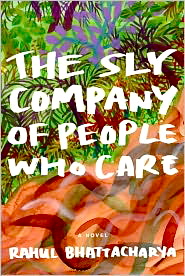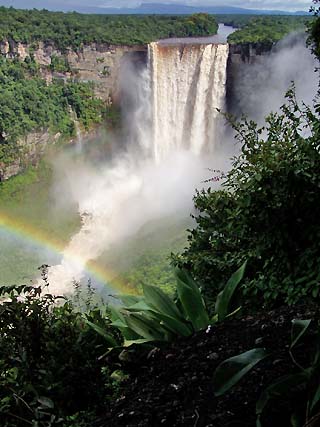“Guyana the most beautiful country in the world…You cyan see Guyana in one life, you know. You could see all of it—but not in one life. Too beautiful and too big fuh see in one life.”
 A reporter of cricket matches who also wrote the cricket-tour book Pundits from Pakistan, Indian national Rahul Bhattacharya spent some time in Guyana covering matches in 2003 – 2004, so enjoying the country that he decided to return again later to spend an entire year meeting new people and exploring places most outsiders never come to know. The result is a unique travel book of great originality, chock full of outlandish characters, trips to places the reader will not even have imagined, and risky adventures to the interior.
A reporter of cricket matches who also wrote the cricket-tour book Pundits from Pakistan, Indian national Rahul Bhattacharya spent some time in Guyana covering matches in 2003 – 2004, so enjoying the country that he decided to return again later to spend an entire year meeting new people and exploring places most outsiders never come to know. The result is a unique travel book of great originality, chock full of outlandish characters, trips to places the reader will not even have imagined, and risky adventures to the interior.
Not a “novel” by any definition that I have ever read (though it is described on the jacket as such), the resulting book offers new glimpses into a lesser known part of the world, vibrantly described by a narrator who is obviously a stand-in for the author. Though he may have “fictionalized” characters’ names and some events, the places, social and political history, and reports about some documented recent events in Georgetown are obviously real. The book feels, overall, like a wonderfully described  diary, with events unfolding more or less at random, instead of a carefully planned and organized novel with a controlled set of characters and a fully developed plot leading to a climax and resolution. The only character here with any real depth is the narrator, and he is constantly on the move in search of new adventures. Virtually all the other characters here live “on the edge” and speak a variety of pidgin, with the dialogue often containing vocabulary that the reader must figure out by context.
diary, with events unfolding more or less at random, instead of a carefully planned and organized novel with a controlled set of characters and a fully developed plot leading to a climax and resolution. The only character here with any real depth is the narrator, and he is constantly on the move in search of new adventures. Virtually all the other characters here live “on the edge” and speak a variety of pidgin, with the dialogue often containing vocabulary that the reader must figure out by context.
The book is divided into three parts. Part I follows the unnamed narrator as he makes the acquaintance of “Baby,” a “Non-Practicing Fundamentalist Eighth Day Adventurist” who claims to have just been released from jail after slashing his former partner nine times with his knife and killing him. He gives the narrator a colorful “pebble” made of melted toothbrushes, which he says was made in jail. He is anxious to return to his “occupation” as a “porknocker,” someone who travels to the watery interior to pan for gold or diamonds. Before long, the narrator is traveling with Baby and a couple of other equa lly colorful characters as they go by bus, jeep, motorboat, plane, and for hours on foot to the interior to “work the water.” Throughout, the author fills this journey with local color—the houses on stilts, car shells “growing out of the mud, shot through with razorgrass,” “run-over dogs ground into the asphalt,” sandpits big enough to swallow whole villages, and “river and bush and forest tugging at each other.” Everything here is larger than life: Kaieteur Falls, five times higher than Niagara; the tank bromeliad, about fifteen feet tall; and the camoudi, a Guyanese anaconda, reported to grow up to forty feet long.
lly colorful characters as they go by bus, jeep, motorboat, plane, and for hours on foot to the interior to “work the water.” Throughout, the author fills this journey with local color—the houses on stilts, car shells “growing out of the mud, shot through with razorgrass,” “run-over dogs ground into the asphalt,” sandpits big enough to swallow whole villages, and “river and bush and forest tugging at each other.” Everything here is larger than life: Kaieteur Falls, five times higher than Niagara; the tank bromeliad, about fifteen feet tall; and the camoudi, a Guyanese anaconda, reported to grow up to forty feet long.
Part II begins almost as a geography lesson, then moves into political and social history, emphasizing the standing conflicts between those of African and East Indian descent, now the major part of the population, both groups having been brought to Guyana originally as slaves. He also spends considerable time delving into the dozens of drug war killings in and around Georgetown in 2005 – 2006, involving drug gangs under the control of Shaheed (Roger) Khan. He points out that 20% – 60% of the country’s whole economy was based on the cocaine trade, and many of these killings were in response to Kahn’s war against the drug gangs of the “African Taliban.”

Part III gives a significant role to a woman for virtually the first time in the book, as the narrator becomes, for a time, the bewitched companion of Jankey, a seductive young woman who wants to escape Guyana to someplace more exciting. In this section, the author travels with her, without visas, to Venezuela, a journey which leads to some new understandings about himself, her, and the political and legal realities. It is also the first time in the novel in which the author seems be genuinely involved with someone whose life is, and always will be, different from his own. He and the other characters are clearly not his equals, in his own eyes–and he can always go home.
The author does not include (and is, of course, under no obligation to include) information about the hard-working middle-class in Guyana, especially in Georgetown, as that group is not really relevant in his stories, nor, it seems, does he meet people who speak English as grammatically as he himself does—though there are educated Guyanese who speak grammatically, too. Many of these citizens do not leave the country for better jobs, choosing to stay where they are, working to improve their own country and improve the schooling for their children. This book is a lively account of those who live on the fringes, taking big risks and chances, and surviving any way they can. Those who are looking for a balanced picture of Guyana, a country of extraordinary beauty and much charm, will want to look elsewhere.
(and is, of course, under no obligation to include) information about the hard-working middle-class in Guyana, especially in Georgetown, as that group is not really relevant in his stories, nor, it seems, does he meet people who speak English as grammatically as he himself does—though there are educated Guyanese who speak grammatically, too. Many of these citizens do not leave the country for better jobs, choosing to stay where they are, working to improve their own country and improve the schooling for their children. This book is a lively account of those who live on the fringes, taking big risks and chances, and surviving any way they can. Those who are looking for a balanced picture of Guyana, a country of extraordinary beauty and much charm, will want to look elsewhere.
Photos, in order: The author’s photo appears on http://www.hindu.com
Kaieteur Falls is from: http://www.newworldencyclopedia.org
Two porknockers are seen on: http://www.vidoevo.com.
The Guyanese camoudi, an anaconda which can reportedly grow up to forty feet long, seen here. http://www.guyana.org
Note: An updated article about drug czar Shaheed Kahn from the Stabroek News may be found here: http://www.stabroeknews.com
The review of a wonderful book by Arif Ali, primarily photos taken all over Guyana, may be found here: http://marywhipplereviews.com/arif-ali-guyana/
A YouTube video about porknocking may be seen here: These porknockers are panning for gold, not diamonds, using the same techniques. The first five minutes show the difficulties of getting to the area. Then you see the porknockers at work.
